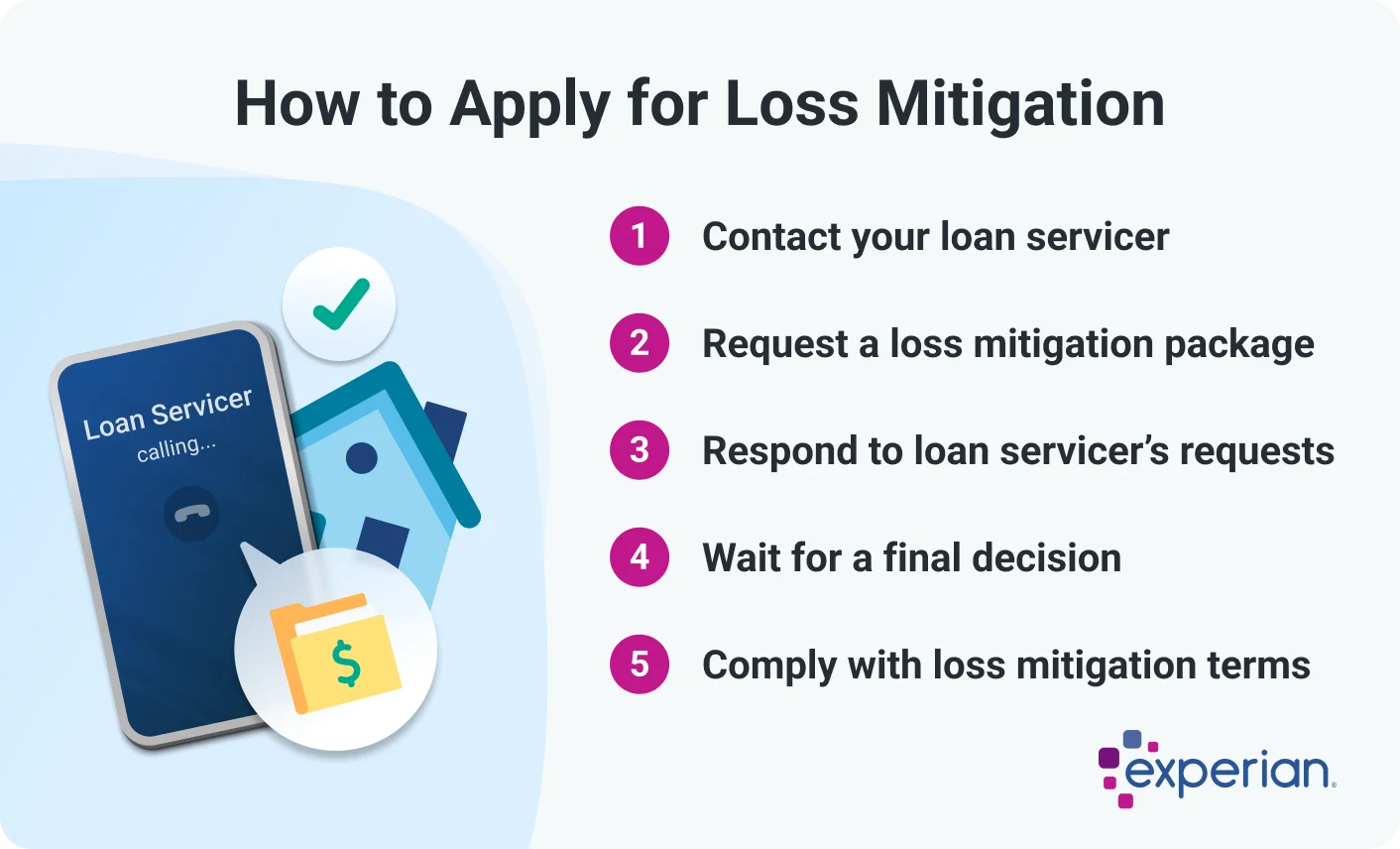What Is Loss Mitigation?
Quick Answer
Loss mitigation is an alternative to foreclosure that allows you to seek alternative hardship options like loan forbearance, loan modification, short sales or a deed in lieu of foreclosure.

When you're struggling to make your mortgage payments and worried about foreclosure, loss mitigation could help. Loss mitigation is an alternative to foreclosure that includes loan forbearance, loan modification, short sales or a deed in lieu of foreclosure. Depending on your situation, you may qualify for various loss mitigation options offered by your loan servicer.
What Is Loss Mitigation?
Loss mitigation is an alternative to foreclosure that may be available from your mortgage loan servicer. Lenders generally prefer to avoid foreclosing on a home, which is a costly, time-consuming process. Loss mitigation programs can help you stay in your home or give you control of how you leave it—both of which are preferable to having a bank seize the home.
While both foreclosure and loss mitigation can seriously damage your credit, loss mitigation has a slightly lesser impact.
Learn more: How Can I Stop Foreclosure?
Compare mortgage refinance rates
Check today’s refinance offers and current rates to find the right loan to lower payments or shorten your term.
Loss Mitigation Options
If you're having trouble paying your mortgage, contact your loan servicer to learn more about your loss mitigation options. Depending on your financial situation and your loan servicer's policies, you may have several alternatives.
| Option | How It Works | Best For |
|---|---|---|
| Repayment plan | Catch up on missed payments by adding them to future payments | Short-term hardship; you'll be ready to resume full payments soon |
| Forbearance | Temporarily pauses or reduces payments during financial hardship | Temporary hardship; you expect to recover soon |
| Loan modification | Permanently changes loan terms | Long-term hardship; you need a sustainable payment solution |
| Short sale | Sell the home for less than owed with lender approval to avoid foreclosure | Those unable to afford their home and whose property's value has declined |
| Deed in lieu of foreclosure | Transfer ownership to the lender and erase your mortgage debt to avoid foreclosure | Those who can't sell their home and want to avoid the foreclosure process |
Repayment Plan
Although state laws vary, lenders can usually start pre-foreclosure proceedings once your mortgage payment is 90 days late. If you've missed a few mortgage payments but haven't hit the 90-day mark and are ready to get back on track, your lender may agree to a repayment plan. A repayment plan typically involves making a lump-sum payment or temporarily increasing your mortgage payments until the missed payments (plus interest) are repaid.
Forbearance
Major medical expenses, a divorce or other life crises could make it hard to pay your mortgage. Forbearance programs can help by reducing or pausing your mortgage payments for up to 12 months while you get back on your feet (and stay in your home). These programs are designed for borrowers experiencing short-term financial hardship.
To qualify for mortgage forbearance, you generally need good credit and proof that you'll be able to restart your mortgage payments when forbearance ends. At that point, you'll also need to repay the skipped payments plus interest, usually in a lump sum or in installments added to your regular payments.
Loan Modification
A loan modification permanently adjusts the terms of your mortgage to make payments more manageable so you can keep your home. For example, your lender might modify your mortgage by lowering the interest rate, extending the repayment term, converting an adjustable-rate mortgage (ARM) to a fixed-rate loan or, in rare cases, reducing your loan principal.
To be eligible for loan modification, you generally need to have missed at least one mortgage payment or be about to miss one. Lenders may also offer mortgage modifications if, at the end of your mortgage forbearance, you find you can't resume payments as planned. Any missed or skipped payments get added onto the amount you owe.
Learn more: How Can I Get Mortgage Modification?
Short Sale
When home values decline, you may end up underwater, or owing more than your home is worth. If you're in this situation and can't make your loan payments, a short sale allows you to exit your mortgage without the distress of foreclosure.
You'll need to prove that you can't pay your mortgage and receive your loan servicer's approval. You then sell your home for less than the amount owed on your mortgage; the lender keeps the sale proceeds. This won't be enough to pay off your mortgage, so your lender may require you to pay all or part of the outstanding balance or may forgive your debt.
Tip: If you can't make your mortgage payments and have equity in your home, selling it and paying off your mortgage can be an alternative to loss mitigation.
Deed in Lieu of Foreclosure
Sometimes called voluntary foreclosure, a deed in lieu of foreclosure transfers ownership of your home to the lender. In return, your mortgage debt is wiped out and you avoid foreclosure. (If your loan balance is more than the home is worth, you may have to pay the difference.)
Lenders may agree to a deed in lieu of foreclosure if you've been delinquent on your mortgage for a long time, demonstrate that you won't be able to resume your payments, don't qualify for mortgage modification or have tried unsuccessfully to sell your home.
If you're considering applying for a deed in lieu of foreclosure, it's wise to consult with a foreclosure attorney. You can also get free advice from a counselor approved by the Department of Housing and Urban Development (HUD).
How to Apply for Loss Mitigation
Follow these steps to apply for loss mitigation.
- Contact your loan servicer right away. Your loan servicer may be different from your lender; you can find their contact information on your monthly mortgage bill or on their app or website. Explain your situation and ask what you can do to prevent foreclosure.
- Request a loss mitigation package. This is an application you must complete and return along with any required supporting documentation. You'll typically need to provide things like pay stubs, tax returns, bank statements and a hardship letter.
- Respond to your loan servicer's requests. Reply promptly whenever your loan servicer asks for clarification or additional documentation.
- Wait for a final decision. Expect to wait at least 30 days for your loss mitigation application to be reviewed. In some cases, it may take 90 days or more to receive a decision.
- Comply with the loss mitigation terms. It's important to follow the requirements of any loss mitigation plan that your lender approves. For example, if you're approved for a mortgage modification, you may be asked to make three trial payments; be sure to make them on time and in full.
Tip: Complete your application for loss mitigation as soon as possible. If you submit the application before foreclosure starts, your loan servicer cannot begin foreclosure proceedings while your application is being evaluated.

Frequently Asked Questions
The Bottom Line
Loss mitigation is a better option than foreclosure, but can still do serious harm to your credit score. After a loss mitigation, take steps to get your credit back on track by paying down debt, keeping your credit utilization rate low and paying your bills on time.
Also, consider signing up for free credit monitoring from Experian. You'll get access to your FICO® ScoreΘ and receive alerts of important changes to your credit report. It's a great way to keep tabs on your progress as you work to improve your credit score.
Curious about your mortgage options?
Explore personalized solutions from multiple lenders and make informed decisions about your home financing. Leverage expert advice to see if you can save thousands of dollars.
Learn moreAbout the author
Karen Axelton specializes in writing about business and entrepreneurship. She has created content for companies including American Express, Bank of America, MetLife, Amazon, Cox Media, Intel, Intuit, Microsoft and Xerox.
Read more from Karen